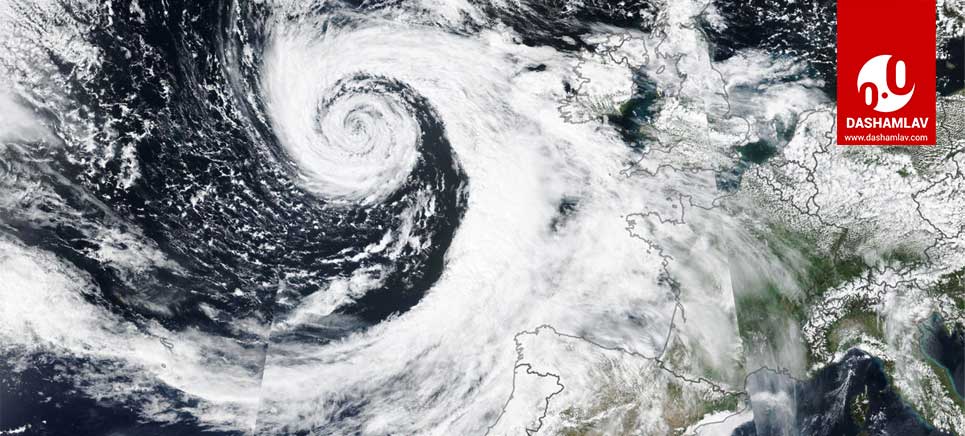The term wind refers to the natural movement of air at any velocity along the surface of the Earth in a horizontal direction. However, this description of wind undergoes a change when the reference point is anything but Earth’s atmosphere. In a wider context, especially in reference to outer space where the air is absent, wind refers to the flow of gases in a huge amount.
Wind Direction
The wind blows as a result of a difference in air pressure. The wind flows from a high-pressure region towards the low-pressure region. The direction from which the wind originates is called its wind direction. If the wind is flowing from east to west, the wind direction would be east.
Coriolis Effect
Interestingly, the wind flowing within Earth’s atmosphere does not follow a straight path. This happens because of the Earth’s rotation which is responsible for causing the Coriolis Effect. As a result of the Coriolis Effect, the wind traveling in a straight path gets deflected towards the right in the Northern Hemisphere and towards the left in the Southern Hemisphere. Thus, if you are in standing in the Northern Hemisphere of Earth, you will observe that the wind near a low-pressure region blows in an anti-clockwise direction. In contrast, if you are standing in Earth’s Southern Hemisphere, you will observe that the wind near a low-pressure region blows in a clockwise direction.
Wind Speed
Wind Speed is the rate at which air moves from one region to another. The unit to measure wind speed is meter per second (m/s). Wind Speed is commonly measured with the help of an anemometer.
What are the factors affecting wind speed?
Wind speed is affected by numerous factors. These include the difference in air pressure, local weather, and strong winds blowing in the upper troposphere are some of the major factors influencing the wind speed.

1. Air pressure difference
There is a direct correlation between wind speed and the air pressure difference between the two regions. When the difference in air pressure is very high, the wind would blow at a great speed from a high-pressure area to a low-pressure area.
2. Local weather
Local weather conditions also influence the speed of the wind to a great extent. For example, the development of storms or cyclones in an area may severely affect the wind speed.
ALSO SEE: Local Winds of the World
3. Strong winds in the upper troposphere
Strong winds in the upper troposphere, called Rossby waves, flow from west to east on a global scale all across the Earth. These winds are also known as westerlies. The westerlies flow at a different speed than the winds blowing in the lower tropospheric region.
Wind Pattern
The surface of the Earth is not evenly heated by the rays of the sun. Factors like the Earth’s ellipsoid shape, the rotation, and revolution of the Earth, and its 23 1/2 degree tilted axis – are responsible for this uneven heating of the Earth’s surface. This differential heating of Earth results in the creation of a large global wind pattern.
Wind pattern is mainly divided into three categories:
1. Trade Winds or Prevailing Easterlies
Trade winds are permanent prevailing winds flowing in the east to west direction from horse latitudes (about 30 degrees north and south of the equator) on either side of the hemisphere towards the equator. The trade winds coming towards the equator from both the Northern and Southern Hemisphere converge or meet at a point called Intertropical Convergence Zone or ITCZ
2. Prevailing Westerlies or Anti-Trade Winds
The prevailing westerlies blow from high-pressure areas in the horse latitudes towards the poles. They are also known as anti-trade winds or simply westerlies as they blow from west to east. They flow between 35° to 65° latitudes in both hemispheres. These prevailing westerlies are known for steering in the mid-latitude cyclones, sometimes called extratropical cyclones. Cyclogenesis or extratropical transition are the main reasons behind the formation of these cyclones.
3. Polar Easterlies
These are dry and cold winds blowing from the polar high pressure in the north and south poles towards the temperate low-pressure belts. They originate from the Tundra and Icecap regions of the Poles. Interestingly, polar easterlies blow more regularly in the South Hemisphere in comparison to the Northern Hemisphere.
Use the citation below to add this article to your bibliography
"Wind: Meaning, Direction, Speed & Global Wind Pattern & Map." Dashamlav.com. Web. 13 June 2025. <https://dashamlav.com/wind-meaning-direction-speed-global-wind-pattern/>
Dashamlav.com, "Wind: Meaning, Direction, Speed & Global Wind Pattern & Map." Accessed 13 June 2025. https://dashamlav.com/wind-meaning-direction-speed-global-wind-pattern/
"Wind: Meaning, Direction, Speed & Global Wind Pattern & Map." (n.d.). Dashamlav.com. Retrieved 13 June 2025 from https://dashamlav.com/wind-meaning-direction-speed-global-wind-pattern/
